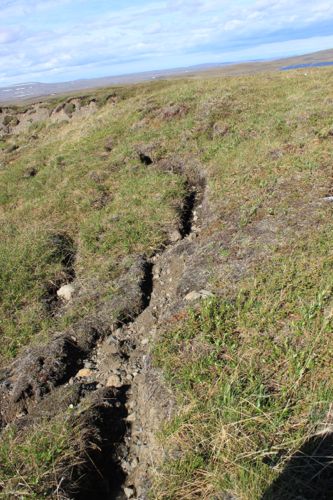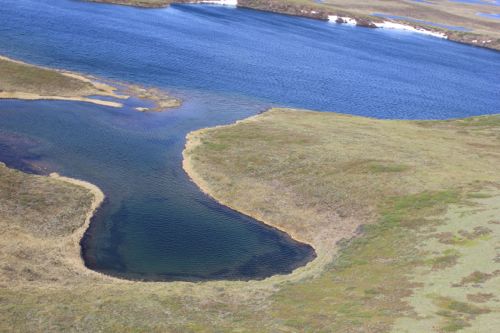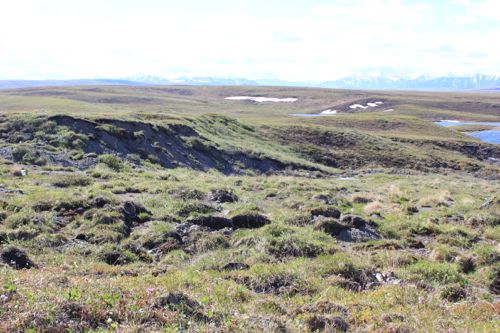PermafrostPermanently frozen ground.
A unique characteristic of land in high latitudes is permafrost, or ground that remains frozen for at least two years. If you live in an area where the ground freezes in the winter, you will understand what this means. During winter, a garden cannot be dug as the ground can't be breached by a shovel. Underground pipes could freeze and burst. However, spring weather warms and thaws the soil.
PermafrostPermanently frozen ground. soil does not thaw in the spring or summer. A shallow layer of soil at the top of the ground thaws enough for plants to grow and animals to burrow. This top layer is called the active layer of soil. Water from rain and melted ice and snow stays in the active layer, unable to penetrate the permafrost. Walking on tundra can be tricky because of the patches of wet, boggy soil and puddles.
Mosses, plants, and trees grow in the active layer. The mosses and plants insulate the ground, protecting the permafrost from sunlight and heat.

PermafrostPermanently frozen ground. can be tens of thousands of years old, and is a catchment for remains of things that were living before the past ice age. In 2007, remains of a baby mammoth were found on the Siberian tundra. The mammoth was remarkable because its body was well preserved. For more details see Lyuba the mammoth
Most of what is trapped in permafrost is not as attention-getting as a baby mammoth, but very important to consider when thinking about climate change. PermafrostPermanently frozen ground. is considered a carbon sink, as it stores high amount of organic materials, included decayed plants and animals. By definition, organic material contains carbon. Research conducted at Toolik Field Station looks at the carbon contained in the permafrost and how it is being released into the atmosphere.

As the permafrost thaws, sections of land become unstable as the area loses its strong, frozen base. Soil sinks, opening cracks in the landscape. Large sections of soil can give way, first sinking, and then pulled down a slope by gravity. This area of land disturbance is called a thermokarst.

As you see in the picture, a thermokarst creates a large area of land disturbance. The soil literally opens up, exposing previously frozen ground to the sun and air. The active layer of soil on the tundra increases. This active layer is exposed to water, microbes, and sunlight. These factors enhance release of carbon. The temperature of the soil is 5º C just a few centimeters below the surface.

As readily seen from the air, soil moves downhill. Here, the soil falls into a lake, depositing minerals into the water and lake bed. The different colors in the photo indicate varying levels of material in the water. The soil brings microbes and carbon into the water. Dr. Byron Crump, Oregon State University, studies how microbes mitigate carbon release into the atmosphere.

The exposed soil is darker than the plant-covered tundra and absorbs more sunlight and heat, further thawing the permafrost. A self-sustaining cycle of heat and thaw sets up, stopped when winter sets in.

More information about permafrost features can be found at: Alaskool.org and


Comments